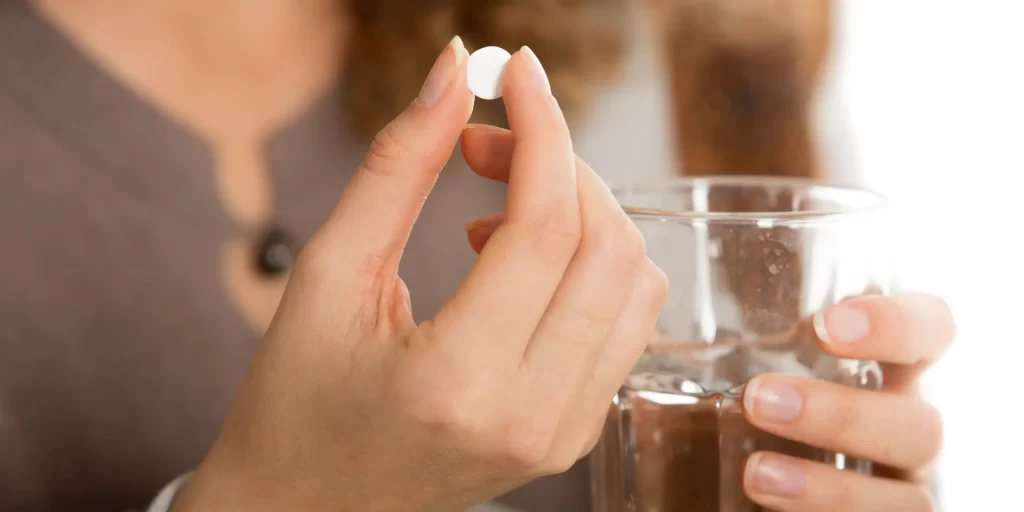How Long Does Oxycodone (OxyContin, Percocet) Stay in Your System?
Written by Abby Doty
& Medically Reviewed by Leila Khurshid BCPS, PharmD
Medically Reviewed
Up to Date
Last Updated - 6/17/2022
View our editorial policy
Oxycodone is an opioid pain reliever only available by prescription. The drug effectively manages moderate to severe pain, but it is commonly misused for its euphoric effects. Oxycodone misuse and abuse can carry a risk of physical dependence and cause severe withdrawal reactions, overdose and death.
Due to the risks associated with oxycodone misuse, drug tests are commonly used by doctors, employers and law enforcement. How long oxycodone stays in your system and can be detected through various testing methods depends on several factors.
What Is Oxycodone?
Oxycodone is a potent opioid medication available by prescription only. It is classified as a Schedule II medication under the Controlled Substances Act, meaning it is among the most addictive category of medications while still having a valid medical reason to prescribe it.
Oxycodone is used to treat pain and often sold under brand names like OxyContin (extended-release oxycodone) or combined with acetaminophen (Tylenol) in Percocet. Sometimes, this can be for a short time, like after surgery, or it can be for chronic pain like with cancer.
Oxycodone Brand Names
Oxycodone is available in a variety of formulations and in combination with other medications. These formulations range from immediate release to extended release. Some examples include:
- OxyContin: Extended-release oxycodone
- Percocet: Immediate-release oxycodone and acetaminophen
- Roxicet: Immediate-release oxycodone
- Percodan: Immediate-release oxycodone and aspirin
- Oxycet: Immediate-release oxycodone and acetaminophen
How Is Oxycodone Metabolized?
Metabolism describes how the body processes or breaks up a substance until it’s gone or removed from the body. After being ingested, oxycodone is metabolized by the liver into its metabolites — noroxycodone, oxymorphone and noroxymorphone. This happens through chemical reactions with a liver enzyme called cytochrome P450. After being metabolized by the liver, it is eliminated through the urine.
Other medications can speed up or slow down cytochrome P450, significantly impacting oxycodone metabolism. These drug interactions can lead to much higher or lower concentrations of oxycodone metabolites than expected.
How Long Does It Take for Oxycodone to Kick In?
A variety of factors can influence how long it takes for oxycodone’s effects to be felt, including liver and kidney function, age, other medications or genetics. The formulation of oxycodone is also important, as some are extended-release and others are immediate-release.
Generally, it will take about 10–15 minutes to feel pain relief from immediate-release formulations of oxycodone, like Percocet or Roxicodone. For extended-release formulations like OxyContin, pain relief can take within an hour.
How Long Does OxyContin Last?
For most immediate-release formulations of oxycodone, effects usually last about 4.5 hours. OxyContin, however, lasts 8–12 hours because it is an extended-release version. The amount of time that oxycodone can be felt in the body depends on several factors: liver and kidney function, age, genetics or other medications that can impact cytochrome P450 enzymes.
Another thing to consider is eating food with the medicine. Extended-release oxycodone is absorbed similarly whether it was taken with food or not. However, eating food with your many immediate-release oxycodone drugs, like Percocet or Percodan, can delay the drug’s peak concentration by 1–2 hours.
Oxycodone Half-Life
A medication’s half-life is the time it takes for the body to metabolize and excrete half of one dose. The number of different oxycodone products and combinations with other pain medications makes it difficult to generalize the half-life of oxycodone.
Oxycodone, in general, is a relatively short-acting opioid with a half-life of about 2.5 hours. However, this can change when oxycodone is combined with another medication or if it’s an extended-release formulation. Also, because every person metabolizes this medication differently, your age, genetics and other factors can all impact the half-life of oxycodone in your body.
Some specific examples of oxycodone half-lives include:
- OxyContin half-life: 4.5 hours
- Percocet half-life: 4.5 hours
- Roxicet half-life: 3–5 hours
- Percodan half-life: 3–5 hours
- Oxycet half-life: 3–5 hours
How Long Does Oxycodone Stay in Your System?
Due to the high risks associated with oxycodone misuse and addiction, drug tests are commonly used by doctors, employers and law enforcement to identify oxycodone use. Oxycodone can be detected through a variety of tests, though the detection times for oxycodone depend on the type of test administered.
How Long Does Oxycodone Stay in Your Urine?
Urine screens are the most commonly used type of drug test. These drug tests can include a variety of substances but do not require specialized personnel, a laboratory or other medical environment. This type of drug testing is also not as invasive as some others, like blood tests. Generally, urine drug screens are also cheaper than other methods.
Oxycodone is detectable in urine for up to three days after the last use, though it can depend on the dose, frequency of use and the individual metabolism of the person.
How Long Does Oxycodone Stay in Your Blood?
Drug tests using blood are also sometimes done; however, this type of test requires trained personnel and a medical facility and can be more expensive than other types of tests. Blood tests can be more sensitive and specific, meaning they can often detect medications at a much lower level and better differentiate between specific drugs than some other methods.
Oxycodone can be detected in the blood for three to six hours after a dose. Detection using this method can also vary depending on dose, frequency of use and the person’s metabolism.
How Long Does Oxycodone Stay in Your Saliva?
Saliva drug screenings are becoming more popular because these tests are quick and non-invasive. They provide a rapid result in situations where drug use would affect safety, like in roadside testing by law enforcement. Oxycodone use can be detected in saliva as soon as 15 to 30 minutes after use and up to 34 hours after use.
How Long Does Oxycodone Stay in Your Hair?
Testing for oxycodone in hair cannot indicate the amount of drug in the body or current intoxication, but it can provide evidence that a person was exposed to a drug. Oxycodone’s metabolites can be detected in a hair test up to 90 days after the last use.
What Can Cause a False Positive Drug Test for Oxycodone?
It is possible to find false positives when looking for oxycodone on a drug test. A false positive for oxycodone occurs when the drug test detects the presence of something that chemically resembles oxycodone but is not actually oxycodone. This is referred to as cross-reactivity.
False-positive drug screenings for oxycodone can occur with the ingestion of certain substances, such as poppy seeds or certain medications. The medications known to affect opioid drug screenings include quinolone antibiotics, rifampin, verapamil, quetiapine and diphenhydramine.
Factors Influencing How Long Oxycodone Stays in Your System
A variety of factors impact how long oxycodone stays in your system. These factors can cause significant differences in detection times and can vary from person to person. These may include:
- Length of use: Using oxycodone over the long term can result in a build-up of the drug in the body. This can result in oxycodone lasting longer in the body than if the same dose were used short term.
- Method of use: When taken as prescribed, oxycodone should only be taken orally. However, some methods of abuse include injecting, smoking, or snorting oxycodone, which can impact the length of time oxycodone stays in your system.
- Age: Generally, older patients have slower metabolism of oxycodone.
- Liver and kidney function: Oxycodone is metabolized by the liver and excreted by the kidneys. Damage to either organ can result in slower oxycodone metabolism.
Oxycodone Addiction and Abuse
Drugs like Percocet and OxyContin carry a high potential for abuse and addiction because of their oxycodone component. Dependence on these medications can happen even after using them for just a few days, so it is important to use them at the lowest dose possible and for the shortest time you can. Opioids like oxycodone can trigger the release of endorphins, a chemical in the brain responsible for pleasurable feelings, which dull feelings of pain. This same mechanism can lead to cravings for the drug over time and eventual addiction.
Signs you may have a problem with oxycodone include:
- Cravings for the drug
- Taking this medication differently than prescribed or without a prescription
- Taking more oxycodone or more often than prescribed
- Experiencing withdrawal symptoms when you stop
- Lying or stealing to get more oxycodone
Opioid Addiction Treatment
If you or someone you know is struggling with oxycodone addiction, The Recovery Village Ridgefield can help. We are located a short drive from Portland, Oregon with a secluded and tranquil campus. Our multidisciplinary team of licensed professionals will guide you through a personalized treatment program suited to your needs, which may include:
- Medical detox
- Inpatient or outpatient care
- Individual and group therapy
- Medication-assisted treatment
- Dual diagnosis care for co-occurring disorders
- Family therapy
- Support groups
- Aftercare planning
- Teletherapy
To learn more about our treatment programs and get started on the path to recovery, contact The Recovery Village Ridgefield today to speak with a representative.
Sources
- Cone, E. J., et al. “Prescription opioids. III. Disposition of oxycodone in oral fluid and blood following controlled single-dose administration.” Journal of Analytical Toxicology, April 2015. Accessed August 12, 2019.
- Keary, Christopher J., et al. “Toxicologic Testing for Opiates: Understanding False-Positive and False-Negative Test Results.” The Primary Care Companion for CNS Disorders, July 26, 2012. Accessed August 12, 2019.
- Drugs.com. “Oxycodone Monograph for Professionals.” March 29, 2021. Accessed April 5, 2022.
- ARUP Laboratories. “Drug Plasma Half-Life and Urine Detection Window.” October 2021. Accessed April 5, 2022.
- Gryczynski, Jan; et. al. “Hair Drug Testing Results and Self-reported Drug Use among Primary Care Patients with Moderate-risk Illicit Drug Use.” Drug and Alcohol Dependence, August 1, 2015. Accessed April 5, 2022.
View Sources
- Cone, E. J., et al. “Prescription opioids. III. Disposition of oxycodone in oral fluid and blood following controlled single-dose administration.” Journal of Analytical Toxicology, April 2015. Accessed August 12, 2019.
- Keary, Christopher J., et al. “Toxicologic Testing for Opiates: Understanding False-Positive and False-Negative Test Results.” The Primary Care Companion for CNS Disorders, July 26, 2012. Accessed August 12, 2019.
- Drugs.com. “Oxycodone Monograph for Professionals.” March 29, 2021. Accessed April 5, 2022.
- ARUP Laboratories. “Drug Plasma Half-Life and Urine Detection Window.” October 2021. Accessed April 5, 2022.
- Gryczynski, Jan; et. al. “Hair Drug Testing Results and Self-reported Drug Use among Primary Care Patients with Moderate-risk Illicit Drug Use.” Drug and Alcohol Dependence, August 1, 2015. Accessed April 5, 2022.
Authorship






